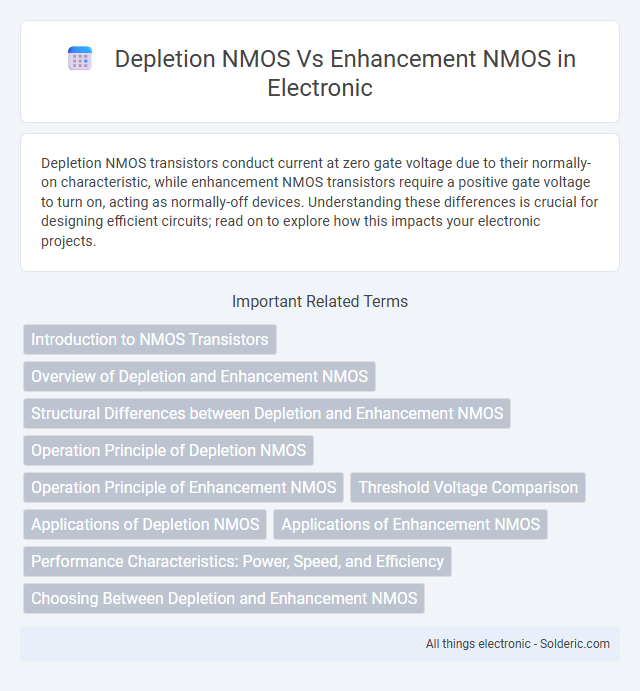Depletion NMOS transistors conduct current at zero gate voltage due to their normally-on characteristic, while enhancement NMOS transistors require a positive gate voltage to turn on, acting as normally-off devices. Understanding these differences is crucial for designing efficient circuits; read on to explore how this impacts your electronic projects.
Comparison Table
| Feature | Depletion NMOS | Enhancement NMOS |
|---|---|---|
| Default Channel State | Normally ON (conducting without gate voltage) | Normally OFF (requires gate voltage to conduct) |
| Threshold Voltage (Vth) | Negative threshold voltage | Positive threshold voltage |
| Gate Control | Gate voltage decreases or increases current flow | Gate voltage required to create channel and conduct |
| Operation Mode | Can conduct at zero gate bias (normally ON) | Conducts only when gate bias exceeds threshold (normally OFF) |
| Usage | Used as load transistors and analog switches | Used in digital switching circuits and logic gates |
| Fabrication Complexity | More complex doping process | Relatively simpler doping process |
Introduction to NMOS Transistors
NMOS transistors are essential components in digital and analog circuits, primarily categorized into Depletion and Enhancement modes based on their channel formation at zero gate voltage. Depletion NMOS transistors have a conductive channel naturally present and can conduct current without gate bias, making them normally-on devices, while Enhancement NMOS transistors require a positive gate voltage to create a conductive channel and are normally-off devices. These differences impact their application in switching, amplification, and integrated circuit designs, influencing their threshold voltage and electrical behavior.
Overview of Depletion and Enhancement NMOS
Depletion NMOS transistors operate with a normally-on channel, allowing current to flow without gate voltage, while enhancement NMOS transistors require a positive gate voltage to create a conductive channel. Depletion-mode devices offer faster switching and are used where default conduction is beneficial, whereas enhancement-mode devices dominate digital logic circuits due to their normally-off state, providing better power efficiency. Understanding the operational differences of your NMOS transistors is critical for optimizing circuit design and performance.
Structural Differences between Depletion and Enhancement NMOS
Depletion NMOS transistors feature a channel that is naturally conductive due to a lightly doped n-type region between the source and drain, allowing current to flow even without a gate voltage. Enhancement NMOS devices have no intrinsic channel and require a positive gate voltage to induce a conductive channel by attracting electrons to the interface, enabling current flow. Your choice between them depends on whether you need devices that conduct at zero gate bias (depletion) or only when actively switched on (enhancement).
Operation Principle of Depletion NMOS
Depletion NMOS transistors operate by default in an ON state, with a conductive channel formed between source and drain even when the gate-to-source voltage is zero, due to the doped channel. Applying a negative gate voltage depletes the channel of carriers, reducing current flow, while a positive gate voltage enhances conduction. This contrasts with Enhancement NMOS, which requires a positive gate voltage to create a conductive channel from an initially non-conductive state.
Operation Principle of Enhancement NMOS
Enhancement NMOS transistors operate by creating a conductive channel between the drain and source terminals only when a positive voltage greater than the threshold voltage is applied to the gate, enhancing the channel's conductivity. Unlike depletion NMOS devices, which have a conductive channel at zero gate bias, enhancement NMOS transistors require this gate voltage to invert the substrate region and form the channel. Your circuits benefit from precise control of current flow, as the enhancement NMOS remains off at zero gate voltage, reducing leakage and power consumption.
Threshold Voltage Comparison
Depletion NMOS transistors feature a negative threshold voltage, allowing them to conduct current even when the gate-to-source voltage is zero, effectively normally-on devices. Enhancement NMOS transistors have a positive threshold voltage, requiring a gate voltage above this threshold to induce a conductive channel, functioning as normally-off devices. The threshold voltage difference between depletion and enhancement modes directly influences their switching behavior and application in digital and analog circuits.
Applications of Depletion NMOS
Depletion NMOS transistors function as normally-on devices, making them ideal for use as load transistors in digital logic circuits and as current sources in analog circuits. Their ability to conduct without gate voltage enables low-power applications and simplifies circuit design by reducing the need for external biasing. You will often find depletion NMOS used in resistor replacement, level shifters, and voltage regulators where stable current control is essential.
Applications of Enhancement NMOS
Enhancement NMOS transistors are widely used in digital logic circuits, such as CMOS technology, because they offer excellent switching characteristics and low power consumption in the off state. These devices are fundamental in implementing high-speed microprocessors, memory arrays, and integrated analog switches due to their ability to remain normally off, reducing leakage current. Enhancement NMOS is also preferred in voltage-controlled resistors and load devices where precise control of conduction is critical.
Performance Characteristics: Power, Speed, and Efficiency
Depletion NMOS transistors typically operate with lower power consumption due to their normally-on nature, which can lead to continuous current flow even without gate voltage, affecting efficiency in low-power applications. Enhancement NMOS devices offer faster switching speeds as they remain off at zero gate voltage and switch on only when a positive voltage is applied, resulting in higher operational speed and better power efficiency during state changes. Your choice between these transistors impacts circuit performance, where enhancement NMOS is preferred for high-speed, low-power designs, while depletion NMOS suits applications requiring normally-on behavior and simpler control.
Choosing Between Depletion and Enhancement NMOS
Choosing between depletion and enhancement NMOS depends on your circuit's startup behavior and power requirements. Depletion NMOS devices conduct current at zero gate bias, making them suitable for normally-on applications or load switches. Enhancement NMOS devices require a positive gate voltage to conduct, offering better control and lower leakage for power-efficient digital circuits.
Depletion NMOS vs Enhancement NMOS Infographic

 solderic.com
solderic.com